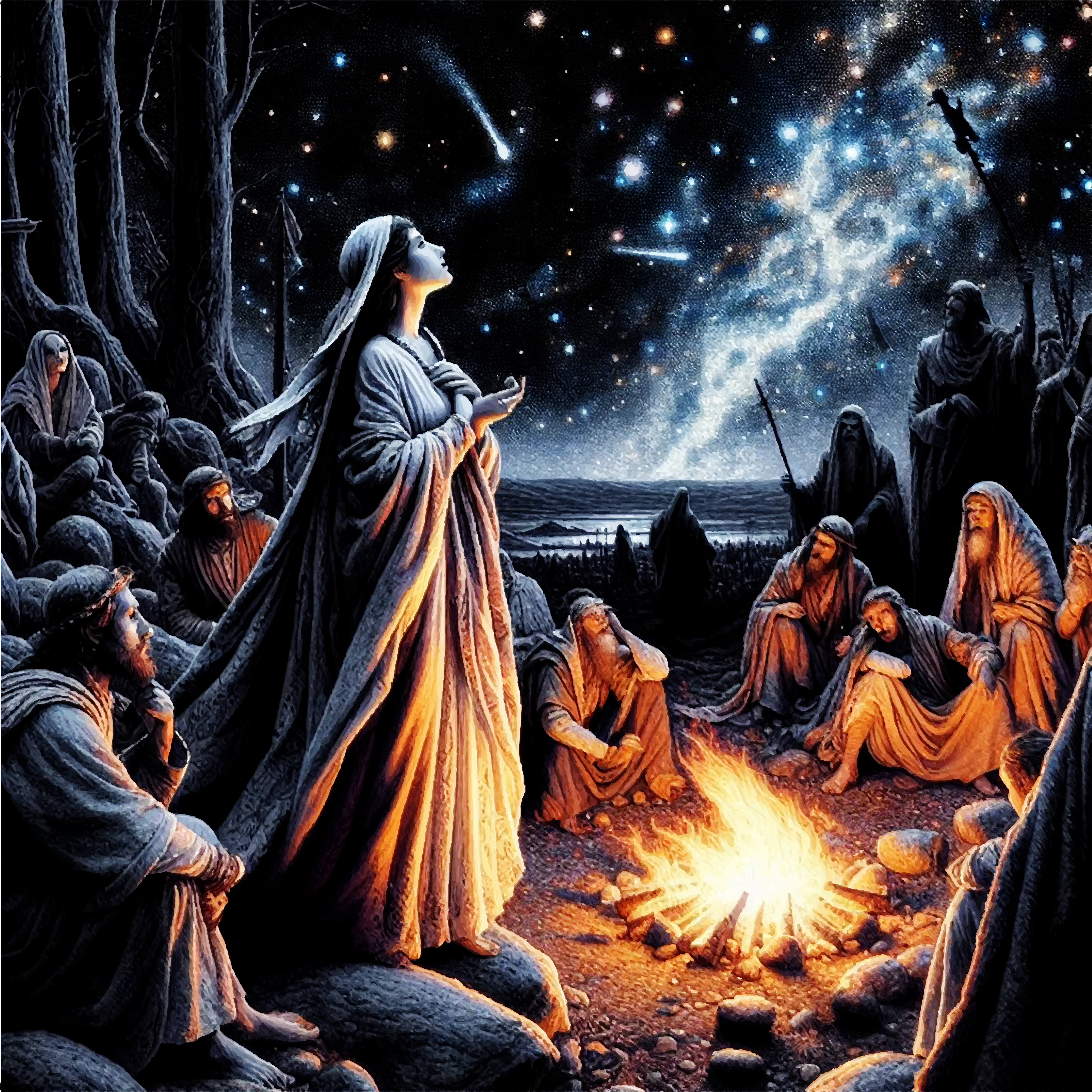“When the prophet or the prophetess dance to hear the will of YHVH, and the will of Ha’Elohim, let the Priests or the Priestess praise YHVH in dance: Let them sing praises unto El Elyon with the timbrel and harp; let the praises of Ha’Elohim be in their mouths.” -4 Moses 33:1-2
One of the most striking distinctions between the traditional Torah and the Torah written to the seed of Joseph on the plates of brass is the portrayal of women, particularly Zipporah. Unlike the biblical accounts that focus primarily on Moses, the Torah from the plates of brass consistently positions women, like Zipporah (Moses’ wife), as an equally important figure working for the Lord in receiving revelations, leading the Israelites, and teaching God’s Torah. There is a significant emphasis on pouring libations and singing and dancing in worship or prophecy. This significant departure from the traditional narrative highlights a more egalitarian approach to spiritual authority, emphasising the important roles both men and women play in God’s plan.
In the traditional Torah, women often occupy secondary roles, primarily defined by their relationships to men. When figures like Miriam, Sarah, and Rebekah appear, their stories are generally presented as side characters to the narratives of their brothers, fathers, or husbands. The Torah found in the plates of brass, however, offers a stark contrast. Here women like Eve, Sariah/Sarah, and Zipporah are depicted as not merely supportive wives, but play active roles as participants in God’s work. This difference is consistently highlighted throughout both 3 Moses and 4 Moses.
Zipporah, Forgotten Prophetess of Israel
 The plates of brass portray Zipporah as a prophetess who receives revelations directly from God. This challenges the traditional view of Moses as the sole prophetic voice and suggests a more open distribution of spiritual authority. For example, in 4 Moses, both Moses and Zipporah are depicted as receiving and delivering God’s law to the Israelites. This shared leadership is a significant departure from the traditional narrative, which primarily emphasizes Moses’s prophetic role.
The plates of brass portray Zipporah as a prophetess who receives revelations directly from God. This challenges the traditional view of Moses as the sole prophetic voice and suggests a more open distribution of spiritual authority. For example, in 4 Moses, both Moses and Zipporah are depicted as receiving and delivering God’s law to the Israelites. This shared leadership is a significant departure from the traditional narrative, which primarily emphasizes Moses’s prophetic role.
Beyond prophetic revelation, Zipporah takes an active role in leading the Israelites. In 3 Moses, she and Miriam, Moses’ sister, participate in establishing the Levitical priesthoods, working alongside Moses to anoint and sanctify both male (Aaronic) priests and female (Miriamic) priestesses (3 Moses 39:25-29). This contrasts with the traditional account, which predominantly focuses on the Aaronic (male) priesthood. She and Miriam play a key role in teaching and guiding the Israelites (3 Moses 25:18). For instance, in 3 Moses, she instructs the daughters of Israel alongside Miriam, emphasizing her role in transmitting God’s law and ensuring its understanding within the community (3 Moses 23:15-16).
The Plates of Brass teach us that Zipporah possessed a deep understanding of God’s Torah and its spiritual implications. For instance, 4 Moses, emphasizes the importance of spiritual understanding and internalization of the commandments, going beyond mere outward obedience. This theme, also reflected in the concept of the “Law of Carnal Commandments,” highlights Zipporah’s role in guiding the Israelites toward a deeper, more meaningful relationship with God.
The Daughters of Miriam
Beyond Zipporah, the plates of brass offer a more expansive view of women’s roles and contributions within Israelite society. This term, Daughters of Miriam, is frequently used in the plates of brass, designates a group of women who serve alongside the Aaronic priests. They play crucial roles in temple rituals, divination, and spiritual leadership within the community (3 Moses 39:27, 4 Moses 38:4, 39:1, Neum 2:4, 7:28). This organized female priesthood stands in contrast to the traditional Torah, which primarily focuses on male religious leadership.
In the times before the Exodus, we see men and women dating in roles of worship, temple ordinances, rituals like pouring libations, and more. Once under the Levitical priesthood however, these roles are divided between the men (Aaronic Priests) and the women (Miriamic Priestesses) indicating that the separation of men and women is the lesser law
The plates of brass consistently link the Daughters of Miriam to the Levitical priesthood, indicating a parallel structure for women within the religious hierarchy. Just as the Levite men are set apart for priestly service, so too are these women designated for specific spiritual roles. Zipporah clothes the daughters of Miriam in their robes and garments, readying them for their participation in sacred ceremonies (3 Moses 39:27). The Daughters of Miriam were clearly involvement in temple rituals.
The plates of brass distinguishes between the roles of the sons and daughters, with the latter being presented as an offering to Miriam, designated to read the skies and divine the letters (3 Moses 19:26). This unique responsibility suggests the Daughters of Miriam may have possessed specialized knowledge in astrology, divination, or other forms of spiritual insight. The plates of brass portray the Daughters of Miriam as spiritual leaders within the community. For instance, Neum 2:4 describes them as leading councils and being recognized for their wisdom. This suggests they held positions of authority and influence, guiding the Israelites alongside their male counterparts.
God Loves His Daughters
The plates of brass present a significant departure from the traditional Torah in their portrayal of women. While the traditional Torah includes instances of women inheriting property, the plates of brass seem to provide a more explicit recognition of women’s rights in this regard. For example, 5 Moses 26:29 acknowledges a woman’s right to inherit property and even rule over her household if she is deemed “worthy” by God. This suggests a more nuanced view of women’s social standing and agency within the plates of brass.
By elevating Zipporah to a position of shared leadership and prophetic authority with Moses, Neum’s oracles as a seer and prophetess, and the contributions of other women like the Daughters of Miriam, the plates of brass offer a more inclusive and egalitarian perspective on the roles of women within the covenant relationship with God. They challenge readers to reconsider traditional interpretations and recognize the vital contributions of both men and women in fulfilling God’s plan.




